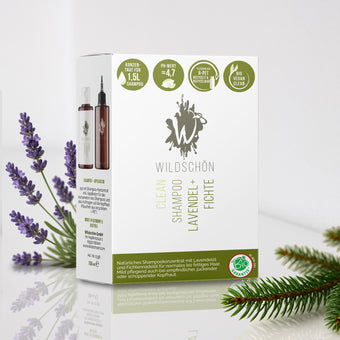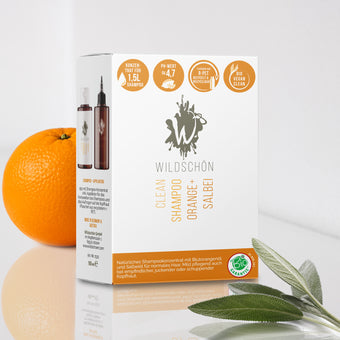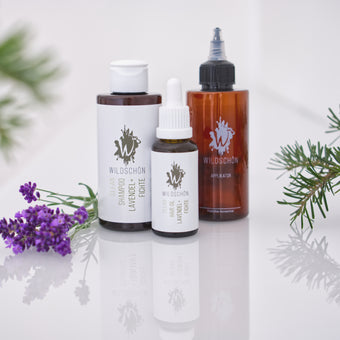What you should know about surfactants in shampoos
- What role do surfactants play in hair care?
- Why you should pay attention to mild surfactants in the shampoo.
- How to distinguish natural surfactants from chemical ones.
After we have already dealt with silicones in shampoos , this article is about an ingredient that is perhaps a little less well-known but still very commonly used: surfactants. Even if you haven't heard the word before, you've probably come into contact with surfactants quite frequently in your life. Because surfactants have been around for a long time. More specifically, they were developed in the first half of the 20th century and supplanted a fairly well-known surfactant: good old soap. As you have probably already seen, we only use coconut glucoside, a particularly mild, sustainable and skin-friendly sugar surfactant, in our shampoo concentrates. In this article we explain what surfactants are all about and why sugar surfactants are the right choice for natural shampoos.
So are surfactants soap or what are surfactants exactly?
Similar to the silicones, there are also different types of surfactants that are used differently. In order to understand this in more detail, let's take another brief excursion into the world of chemistry. Surfactants are often man-made substances. They consist of hydrophilic molecules (also called "head") and hydrophobic molecules (also called "body"). With this 2-in-1 function, surfactant molecules form a kind of bridge between water and another substance (e.g. air or fat). Because their hydrophilic head practically dives into the water, and their hydrophobic body is directed away from the water. Now you may already suspect that this is exactly why surfactants are very useful for many purposes.
Bringing opposites together: Surfactants act as emulsifiers
Anyone who used to pay attention in chemistry may still remember: like dissolves in like. Fats, for example, only dissolve in other fats - and so on. Surfactants cheat this chemical principle. Because, as described above, surfactants can cause two immiscible liquids to mix with each other (e.g. oil and water). This is due to the bridge function described above. Thanks to surfactants, the oil no longer floats on the water, but combines with it. The whole thing is then called an emulsion. So surfactants can be used as emulsifiers. But you can do even more. For example, surfactants reduce the tension between a solid surface and an aqueous liquid. That sounds similar to emulsion production, but it's different. The water-loving head of the surfactant molecules is stuck in the water here and the water-repellent body pushes the water away from the solid surface. The result: the liquid or water flows off the solid surface more easily (keyword: rinse aid). So far so good - but not everything has anything to do directly with shampoo.
Surfactants are responsible for the cleaning effect
Two other effects of surfactants are more important for shampoos: On the one hand, surfactants help small solid particles to detach more easily from surfaces. Well, that sounds more like shampoo (or other detergents). Surfactants in shampoos help to remove fat and dirt particles from the hair. How does it work? The water-loving head is aimed towards the water and the water-repellent part docks onto fat or dirt particles. Now another name for surfactants is explained: They are often also called “washing-active substances”, especially in the case of detergents. Normally, dissolved grease and dirt particles would settle back into the water. On the one hand, because they are heavier than water. On the other hand, because fat does not normally combine with water. That would be pretty impractical when washing your hair. Surfactants normally accumulate in the interface between liquids (head in the water, body away from the water). However, if there is no more space at the border, surfactants form so-called micelles. They do this by pointing their hydrophilic heads toward the surrounding water. The water-repellent bodies, on the other hand, then move away from the water. Water-repellent bodies dock around a dirt or fat particle, while the water-loving heads are on the outside of the particle. In this way, the dirt or fat particles are retained inside the micelle. Now everything can flow away with the water when rinsing out the shampoo. You may already suspect that your hair would not get really clean without surfactants in the shampoo.
Dreams are foam? Then they contain surfactants!
Let's come to the second important effect that surfactants have in shampoos: the nice lather. Many like it not only in the bath water, but also when washing their hair. Somehow we feel our hair is cleaner if it has foamed really nicely beforehand. However, if some of the foam gets into your eyes, it usually doesn't feel so nice anymore. On the contrary: It can burn quite a bit! This is also an effect of the surfactants. Since surfactants can do so much, you will find them in a corresponding number of products: Whether in detergents and cleaning agents, body cleaning products such as shampoo or shower gel, fabric softeners or creams. However, they are also used for industrial applications, for example for the production of paints and plastics or in medicines such as eye drops.
Are surfactants all the same?
You may have guessed it already – the answer is “no”. If you have children, you may be familiar with the label on some shampoo brands that says their product should not sting their eyes. Perhaps you have already discovered the corner with the sensitive products in the drugstore. So there are also differences with surfactants, for example how badly they irritate our skin. Sensitive shampoos and those that are not supposed to sting the eyes can contain less irritating surfactants. However, it is also possible that this effect is caused by other approved ingredients, for example polidocanol (sometimes also found under the name Laureth-9). This is a thickening agent and emulsifier that also has a local anesthetic effect. What burns the eyes can also become a problem for some scalps. Because, like us humans, surfactants do not all “clean” equally well. In other words, they dissolve grease and dirt to different extents. You may remember the commercial in which dishes were cleaned differently with different detergents. Surfactants make it possible.
Aggressive surfactants can stress your scalp
If your favorite cup is sparkling clean, we're happy. However, if surfactants in the shampoo do their job too thoroughly, it can throw your scalp off balance. This is because surfactants not only remove unwanted fat and dirt particles from the hair. They also loosen skin fat, which is contained in the outermost layer of our skin cells and is supposed to protect our skin. If this outermost protective layer of fat is too thin, then pollutants can enter our body more easily through the skin. In addition, the scalp can become dry, itchy, red, or flaky. It is also possible that it becomes greasy more quickly. For example, when the surfactants have a very strong cleaning power and this stimulates the body's own skin oil production. In body care products, when using surfactants, you not only have to look at their cleaning power, but also at their skin compatibility. This is the main reason for our decision to use mild sugar surfactants in Wildschön Clean Shampoo concentrates.
Sustainability of surfactants: They should be degradable
Surfactants can also be differentiated according to the nature of their origin. Synthetic surfactants are produced artificially, i.e. using chemical processes. These are almost all surfactants today. Oil-based raw materials are also often used. At the other end of the "naturalness scale" is lecithin, a naturally occurring surfactant. It doesn't have to be made separately, it's just there. For example in eggs, soybeans or sperm cells of plants. Lecithin is often used as an emulsifier in food, but lacks the cleaning power of other surfactants. However, there are also surfactants of natural origin, which are synthetic but can be made from renewable raw materials such as sugar, coconut oil and corn or potato starch. For example decyl glucoside or coconut glucoside, both of which are made from coconut oil and glucose. However, sustainability does not just include origin. So what about the environmental impact of surfactants once they've done their job and are floating in the sewage? Basically, surfactants in water are harmful to the organisms living there. They can damage their cell membranes and - as in humans - make them more permeable to pollutants. It is therefore important that surfactants are biodegradable. Many of the surfactants used today are, at least in part. Nevertheless, it is not irrelevant which surfactants are floating in the wastewater (i.e. whether they were made from petrochemical or renewable raw materials). For one, many synthetic surfactants are not fully biodegradable. On the other hand, waste water goes through all cleaning stages of a sewage treatment plant in only about two days. Everything that has not been broken down into environmentally friendly components during this time ends up back in our lakes and rivers. It is in the nature of things that the decomposition of surfactants from renewable raw materials is easier and faster for the bacteria in the sewage treatment plant than if they were produced petrochemically. So if you don't want to see the surfactants in your shampoo the next time you swim in the lake, you can do something about it and use products with natural surfactants.
Identify surfactants in shampoos
As so often, a look at the list of ingredients, also known as ingredients or INCI (International Nomenclature of Cosmetic Ingredients), helps here. Every ingredient that exceeds a certain proportion of the total product must be listed here. The further ahead a component is, the larger its share of the total quantity. Unfortunately, surfactants have a variety of names that don't include the word "surfactant." The names end differently depending on which group they belong to. If you think back to the matter of skin compatibility, there are two challenges with surfactants: You not only have to recognize them as such, you also have to know whether they belong to the mild or less mild types. We'll lift a couple of surfactant cloaks of invisibility right now. But because there are so many of them, it's almost impossible to list them all here. But you should know some of the most important ones.
How do I recognize harsh surfactants in shampoos?
Now it's getting a bit chemical, but don't worry - it's understandable. As already mentioned, surfactants differ in their effect. This is because the water-loving part of the surfactant molecule can have different charges. Depending on the charge, surfactants are divided into the following groups: Let's start with the problem child: anionic surfactants. They are negatively charged, cleanse and lather strongly. They are therefore frequently used in detergents and cleaning agents. The harsh surfactants include those with the “-sulphate” suffix. Sodium Lauryl Sulfate (SLS) and Sodium Laureth Sulfate (SLES) are commonly used in cosmetics. They also often hide behind the names sodium lauryl sulfate, sodium alkyloxysulfuricum, sodium dodecylpolyoxyethylene, ether sulfate or sodium lauryl ether sulfate. Rather mild siblings of the anionic family are the glutamates, for example disodium cocoyl glutamate or sodium cocoyl glutamate. Another family of surfactants are the cationic surfactants. They are positively charged. They are not the best cleaning agents, but they have an anti-static effect and make hair (and laundry) soft. That is why they are used more as co-surfactants and emulsifiers. Because they don't clean that well, they can be neglected in the "sharpness ranking".
Non-ionic surfactants are readily biodegradable and mild
Now to the non-ionic surfactants. They are, so to speak, the Switzerland among surfactants: They are neutral, meaning they have no charge. That's why they are particularly mild and skin-friendly, but not so suitable for a foam party. But they still have a good cleaning performance. The non-ionic surfactants also include the sugar surfactants. They are among the mildest. When harsh surfactants are undesirable or not allowed, they are often the first choice. In addition, they are also easily biodegradable. You can recognize sugar surfactants by the fact that their names often contain the words "glucoside" or "sucrose". Well-known and frequently used representatives are coconut glucoside, decyl glucoside or lauryl glucoside. Methylglycoside esters, ethylglycoside esters, N-methylglucamides and sucrose esters also belong in this category, although their names may not immediately suggest it.
Amphoteric Surfactants: Mild but still synthetic
Last but not least we have the amphoteric surfactants. They are positively and negatively charged (yes, you can, but we won't go into that any further here). They are mild, clean well and are biodegradable. Since they don't lather as well, they are usually added as a co-surfactant. From this group, the betaines are often used, easily recognizable by the ending of the same name. But also Disodium Lauroamphodiacetate and Disodium Cocoamphodipropionate are mild amphoteric surfactants. Although some representatives are also approved for natural cosmetics, you will not find them in our Wildschön Clean Shampoos. When it comes to conventional shampoos, you need to know that a surfactant rarely comes alone. As a rule, conventional products contain surfactant mixtures. This is because a surfactant alone cannot meet all the requirements that are desired in a product: With conventional shampoos, this is usually a very fast-cleaning, heavily foaming and fat-dissolving shampoo.
Shampoos without surfactants - is that possible?
Of course, that would also work, because after all, there was life before surfactants were “invented”. It would be quite a challenge though. Because surfactants have been anchored in many places in our everyday life for a very long time, without us being aware of it everywhere. If we were to do without them completely, for example, the washed laundry would come out of the machine with many stains and the care of your hair would not achieve as good results with significantly more effort. Your favorite cream would probably not penetrate the skin as quickly and your toothpaste would stick to your teeth and toothbrush because it would be much harder to spread without surfactants. Hm. Doesn't sound that tempting, does it? Maybe you're thinking now that it would be nicer if you didn't have to do without surfactants entirely. You do not have to. There are surfactants that are skin and environmentally friendly and also sustainable. And because these three topics are just as important to us as they are to you, we use coconut glucoside for our Wildschön Clean Shampoo concentrates.
Conclusion: Skin and environmental friendliness in harmony
This ends our excursion into the world of surfactants. They have many useful effects and can make our everyday life easier in many places. It is important to see the whole picture. Because synthetic surfactants often have a sustainability problem. Therefore, the question arises again: "Does it have to be like this or is there another way?". When it comes to shampoos, we can do without harsh surfactants. Because even with mild surfactants, our Wildschön shampoos clean your hair perfectly and are also kind to the skin and the environment. And, even if it's a little less than with conventional shampoos: You don't have to do without the beautiful foam either.









